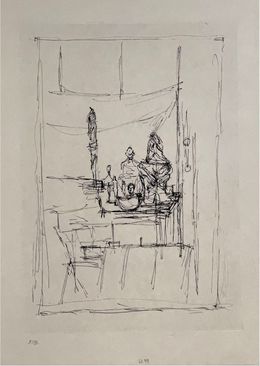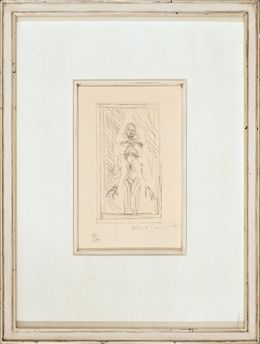
La magie quotidienne (l'atelier)
Alberto Giacometti
Print - 51 x 36 x 0.1 cm Print - 20.1 x 14.2 x 0 inch
$4,205
The painter Alberto Giacometti was born in Switzerland in 1901. His father, Giovanni Giacometti, was a painter and started his son on a creative path early in life. He practiced portraiture first by painting the members of his family. He joined the Geneva School of Fine Arts then trained under Antoine Bourdelle at the Académie de la Grande Chaumière in Montparnasse. His works are world-famous and have been exhibited in the greatest French modern art museums such as Musée de l'Orangerie, the Paris Museum of Modern Art and the Centre Pompidou but also abroad in London, New York, and Copenhagen, etc.
He moved to Paris in 1926 and, like many artists, he became fascinated by cubism, African art and the sculptures of the ancient world. His dreamlike plaster sculptures brought him into contact with surrealists such as Joan Miró and Jean Arp. In 1931, he joined the group of surrealists which included Louis Aragon, André Breton and Salvador Dali. He gradually lost interest in themes of death, violence and uncertainty to undertake work on series of heads and he was to remain obsessed with the representation of them for the rest of his life. He especially sculpted his brother Diego, or his deceased father. This new subject of interest resulted in him being excluded from the Surrealist movement in 1935. He then began to produce large-scale sculptures.
It was in 1947 Giocometti really found his definitive style by depicting long threadlike bodies in bronze. His works are often enclosed in a set space, such as a cage or plinth for example, and this is the representation of a mental space external to the artist. The long characters that occupy this space have very thin bodies, as if they have been dug out and are much like trees. Like past images imprinted in your memories, these bodies are represented in movement, and appear far off and long gone.
The friendship in 1948 between Alberto Giacometti and Pierre Matisse, son of the painter Henri Matisse, was very stimulating for the artist. It was at this period that the sculptor produced his greatest works. He died in 1966 but won many prestigious awards such as the Carnegie Prize in 1961, the Grand Prize for Sculpture at the Venice Biennale in 1962, the Guggenheim Prize in 1964, and the Grand Prix International des Arts de France in 1965.

Print - 51 x 36 x 0.1 cm Print - 20.1 x 14.2 x 0 inch
$4,205

Print - 44.5 x 32.5 cm Print - 17.5 x 12.8 inch
$10,512


Print - 41 x 28 x 0.1 cm Print - 16.1 x 11 x 0 inch
Sold
What are their 3 main works?
What is Alberto Giacometti’s artistic movement?
When was Alberto Giacometti born?